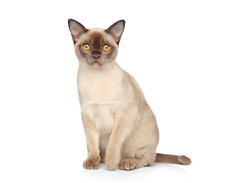Burmese cats have short, fine, satin-like coats, traditionally sable in hue. Dilute coats may be champagne, platinum, or blue. Males average 8 to 10 pounds and females average 6 to 8 pounds. Burmese are compact and muscular, with a heft that has led them to be described as "bricks wrapped in silk." Their big, expressive eyes are one of their most striking features.
This breed enjoys being around humans and is generally accepting of children and other animals.
The Burmese breed is a particularly sociable and people-oriented one; many individuals display personalities that border on dog-like, following their owners around, actively seeking affection and interaction. This breed enjoys being around humans and is generally accepting of children and other animals.
All Burmese are descended from a cat named Wong Mau. She was owned in the 1930s by San Francisco resident Dr. Joseph Thompson.
Burmese are intelligent, playful, affectionate, and sociable. They love to be around people and other animals and to cuddle up in a lap. They often shadow their owners and even attempt to converse with them, and they enjoy when people talk back to them. These animals do best in an active household where there's always some company.
A Burmese cat is a good pick for a household with children or a dog. Burmese cats handle commotion better than many other breeds. Females like to be the center of attention and will establish themselves as active rulers of their home. Males are more laid-back, given to supervising their domain from a warm lap.
The breed is inherently very trusting. While this makes Burmese cats great companions, it doesn't serve them well outdoors. Their trusting natures overshadow any real survival instinct, making the breed poorly suited to going outside. Burmese should be kept as indoor-only pets.
Burmese are a generally healthy breed, and by buying from a reputable breeder who offers a written health guarantee, chances are good of obtaining a healthy cat. This breed is prone to a few conditions, though, including cranial deformities, calcium oxalate urinary tract stones, glaucoma, and hyperaesthesia syndrome, a disorder that causes sensitivity to touch and decreased pain tolerance.
Burmese like to climb to high places. This makes it important to secure any potential perches around the home. It's also advisable to keep these areas free of valued breakable items. A well-balanced diet and preventing obesity are other essential ways to ensure a healthy Burmese.
All cats require regular veterinary checkups, which allow for early detection of health concerns. Catching problems early improves the ability to manage health conditions and often results in a better prognosis.
Burmese are highly intelligent and curious. They love to investigate their surroundings and be entertained by puzzle toys. The breed has a natural predilection for playing with people and other animals. Therefore, they do not need to be trained or coaxed into interaction.
Because Burmese are energetic, intelligent, and sociable, they require a lot of attention and physical and mental stimulation. A companion animal is recommended in households where nobody is home for extended periods during the day. Boredom can easily set in for the Burmese, and they quickly turn to mischief to amuse themselves if necessary.
It's not only its tendency to actively seek out attention that earns Burmese cats a comparison to dogs. They have a built-in love for the game of fetch. It doesn't take long to teach these cats the game, and once they play it, they'll always be eager participants.
Burmese have a low-maintenance coat of short, silky hair that doesn't shed much. Regular petting and a quick weekly brushing are often all that's needed for basic grooming. Routine grooming consists of brushing once per week with a rubber curry brush to dislodge loose hairs and to distribute natural oils over the coat.
This breed needs a nail trimming approximately once per week. Their ears benefit from an occasional cleaning with a mild otic cleanser, and the breed's teeth should be brushed every few days with a feline toothpaste for good dental hygiene and breath fresh.
As Burmese are fond of attention and physical interaction, grooming may not be met with as much resistance as with other breeds. Still, some may naturally resist grooming and cleaning. It's best to begin acclimating Burmese to having their paws, ears, and mouths handled from early on.
A sailor brought Wong Mau, the cat from whom Burmese are descended, to America from Burma in the late 1920s or early 1930s. Dr. Joseph Thomson, a Siamese breeder, took her in and began breeding her with seal-point Siamese cats. When she was bred with one of her offspring, one of the resulting appearances in the litter-dark brown cats with no points-became the basis of what is now known as the Burmese breed.
The Cat Fanciers' Association started registering Burmese in its studbook in 1936. Registration was suspended from 1947 to 1953 until breeders ceased crossbreeding Burmese with Siamese (a practice that later generated the Tonkinese breed). In 1957, Burmese achieved full recognition from the CFA.

